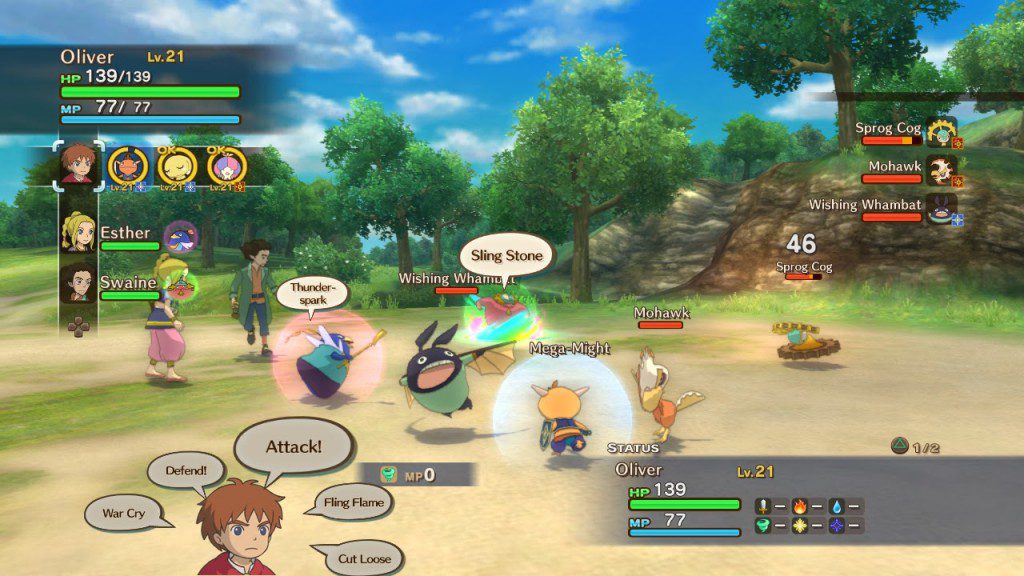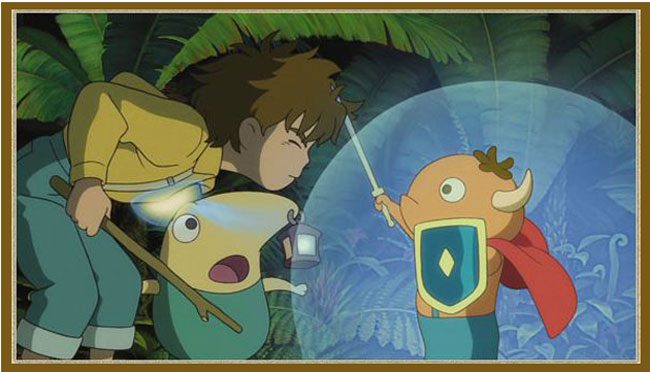Ni No Kuni: Wrath of the White Witch is a difficult game to talk about, not because of its fascinating take on RPG battle systems or the mechanical parts that make up the gameplay, although those parts are amazing, but because it is a difficult game to play emotionally. I have referred to it as “brutal” many times while talking to others about it. After many false starts and trying to write about Ni No Kuni as I would a normal review, I decided to address the parts of the game that make it so outstanding and unusual as both a game and a work of art.
The game is a collaboration between Japanese developer Level-5 of Professor Layton fame and the venerable Studio Ghibli, offering some of the best work from both. Level-5 stayed beholden to most of the JRPG tropes made famous by the NES/SNES era without tumbling into the niche work associated with the genre during this generation (I’m looking at you NIS). Likewise, Ghibli puts the same heart and beauty into every character design and every frame from beginning to end, vaulting Ni No Kuni to the same level of wonder as their films, and I would argue that it surpasses a number of Studio Ghibli films in terms of story and execution.
You take the helm as Oliver, a young citizen of Motorville, a Norman Rockwell-esque town full of charm and polite neighbors. Oliver loves his mother, respects the elders of the town, and always uses the proper form of address when speaking. His (apparent) first moment of rebellion leads to his mother’s untimely death, leaving him alone and devastated. It’s this emotion that awakens the path into the wider world of Ni No Kuni, and the piece that made playing through the game both dazzling and crushing.
Outside the story, Ni No Kuni offers the best JRPG battle system this generation, ironically by aping the systems of classic titles Tales and Pokémon. It is impossible to see the tiny creatures you catch, level, and battle with and not jump to all things Pokémonian in nature. And it’s an apt comparison. While being able to equip your familiars with different weapons and armor is a touch more depth, the basic idea works the same, down to selecting which skills they can have available during battles. Inside the conflicts themselves, you have control of the familiar, or Oliver, and can run around to find better positions and dodge enemy fire, much like the aforementioned Tales games. Both pieces are executed with near perfection, which is essential in a game so dependent on grinding during the 50+ hours most people will spend with it. What keeps it fresh is the incredible versatility in it. Familiars can be rounded up in order to simply “catch them all,” or you can stay with a few trusted companions and not be punished. Familiars evolve as well, but only at the player’s discretion. I would often keep the same type of familiar with all three forms to test out the different advantages to each form. Even changing strategies midway is welcomed, so one never feels trapped regardless of what point in the story they are.
While they may be fantastic, the actually game play portion of Ni No Kuni is, in my mind, secondary. Oliver’s journey to heal himself after a traumatic loss that no child should suffer through is unrepentantly brutal. Early on it is established that the entire game is an analogy for depression and loss. I talked to a number of people who have struggled with depression, bi-polar disorder or other mental health issues (myself included) about the game, and the realism got to all of us at one point or another. Time after time I was forced to step away from the game simply because it was too overwhelming and familiar. It is that realism that cemented my opinion on the game.
I have struggled with severe depression, for years, and I’ve digested countless books and films about depression, and none of them impacted me as much as Ni No Kuni. Oliver is a child, he isn’t an angry and shouting god, he isn’t an angry spouse trying to save or avenge his wife, he is a boy who wants nothing more than to ride a go cart and avoid girls. The journey you take with him is daunting, ugly and brutal, but he keeps going regardless of the roadblocks with the hope of seeing his mother again. He dedicates himself to healing the broken hearts of an entire world on the off chance he might be able to heal his. Oliver is easy to identify with because he starts off as all of us, and his loss is something that can, or has, happened to all of us. His pain and frustration is always underneath, although he denies it. The 50 odd hours spent saving the world is simply window dressing for the incredible burden and pain Oliver lives with. The colorful and seemingly cheerful aesthetic only make the dark points darker, and the cheerful sound effects and cute character designs serve to disarm the player in order to brutally rebuff them at a later point
There are flaws in Ni No Kuni certainly, and anyone that eschews turn based battles or any other traditional JRPG mechanic should steer clear, and the cute factor can occasionally get a bit overboard. However, Ni No Kuni as a whole sits as close to flawless as you can get. Everything it sets out to accomplish is delivered, and then some. This isn’t just one of the best JRPG’s I’ve ever experienced, it is one of the most amazing experiences I’ve had with a game since I first picked up a controller. Level-5 and Studio Ghibli have delivered an absolute masterpiece.
Final Word:
FANTASTIC
To see where this review score falls in our scoring range, please read our review scale guidelines.[/learn_more]




